Post-COVID-19 Rehabilitation: Perception and Experience of Austrian Physiotherapists and Physiotherapy Students
Abstract
:1. Introduction
2. Materials and Methods
2.1. Survey Development
2.2. Survey Participants
2.3. Ethics
2.4. Data Analysis
3. Results
3.1. Response Rates
3.2. Participants Characteristics
3.3. Future Impact of COVID-19 on Physiotherapy Academic Education and Profession
3.4. Physiotherapy Respiratory Rehabilitation of COVID-19 Survivors
3.5. Practical Experience: Physiotherapeutic Examination
3.6. Practical Experience: Physiotherapeutic Treatment
3.7. Device-Supported Respiratory Physiotherapy
4. Discussion
Limitations
5. Conclusions
Supplementary Materials
Author Contributions
Funding
Institutional Review Board Statement
Informed Consent Statement
Data Availability Statement
Conflicts of Interest
References
- World Health Organization. WHO COVID-19 Dashboard. Available online: https://covid19.who.int/ (accessed on 8 August 2021).
- Kreidl, P.; Schmid, D.; Maritschnik, S.; Richter, L.; Borena, W.; Genger, J.-W.; Popa, A.; Penz, T.; Bock, C.; Bergthaler, A.; et al. Emergence of coronavirus disease 2019 (COVID-19) in Austria. Wien. Klin. Wochenschr. 2020, 132, 645–652. [Google Scholar] [CrossRef]
- Correa-Martínez, C.L.; Kampmeier, S.; Kümpers, P.; Schwierzeck, V.; Hennies, M.; Hafezi, W.; Kühn, J.; Pavenstädt, H.; Ludwig, S.; Mellmann, A.; et al. A Pandemic in Times of Global Tourism: Superspreading and Exportation of COVID-19 Cases from a Ski Area in Austria. J. Clin. Microbiol. 2020, 58, e00588-20. [Google Scholar] [CrossRef] [Green Version]
- Gupta, A.; Madhavan, M.V.; Sehgal, K.; Nair, N.; Mahajan, S.; Sehrawat, T.S.; Bikdeli, B.; Ahluwalia, N.; Ausiello, J.C.; Wan, E.Y.; et al. Extrapulmonary manifestations of COVID-19. Nat. Med. 2020, 26, 1017–1032. [Google Scholar] [CrossRef]
- Abdullahi, A. Safety and Efficacy of Chest Physiotherapy in Patients with COVID-19: A Critical Review. Front. Med. 2020, 7, 454. [Google Scholar] [CrossRef]
- Ahmed, T.; Shah, R.J.; Rahim, S.E.G.; Flores, M.; O’Linn, A. Coronavirus Disease 2019 (COVID-19) Complicated by Acute Respiratory Distress Syndrome: An Internist’s Perspective. Cureus 2020, 12, e7482. [Google Scholar] [CrossRef] [Green Version]
- Demeco, A.; Marotta, N.; Barletta, M.; Pino, I.; Marinaro, C.; Petraroli, A.; Moggio, L.; Ammendolia, A. Rehabilitation of patients post-COVID-19 infection: A literature review. J. Int. Med. Res. 2020, 48, 300060520948382. [Google Scholar] [CrossRef] [PubMed]
- Barker-Davies, R.M.; O’Sullivan, O.; Senaratne, K.P.P.; Baker, P.; Cranley, M.; Dharm-Datta, S.; Ellis, H.; Goodall, D.; Gough, M.; Lewis, S.; et al. The Stanford Hall consensus statement for post-COVID-19 rehabilitation. Br. J. Sports Med. 2020, 54, 949–959. [Google Scholar] [CrossRef]
- Kleinitz, P.; Mills, J.-A.; Connolly, B.; Skelton, P.; Smith, G.; Clift, Z. Rehabilitation Considerations during the COVID-19 Outbreak; Pan American Health Organization: Washington, DC, USA, 2020. [Google Scholar]
- Hui, D.S.; Joynt, G.M.; Wong, K.T.; Gomersall, C.D.; Li, T.S.; Antonio, G.; Ko, F.W.; Chan, M.C.; Chan, D.P.; Tong, M.W.; et al. Impact of severe acute respiratory syndrome (SARS) on pulmonary function, functional capacity and quality of life in a cohort of survivors. Thorax 2005, 60, 401–409. [Google Scholar] [CrossRef] [Green Version]
- Lam, M.H.-B.; Wing, Y.-K.; Yu, M.W.-M.; Leung, C.-M.; Ma, R.C.W.; Kong, A.P.S.; So, W.Y.; Fong, S.Y.-Y.; Lam, S.-P. Mental morbidities and chronic fatigue in severe acute respiratory syndrome survivors: Long-term follow-up. Arch. Intern. Med. 2009, 169, 2142–2147. [Google Scholar] [CrossRef] [Green Version]
- Moldofsky, H.; Patcai, J. Chronic widespread musculoskeletal pain, fatigue, depression and disordered sleep in chronic post-SARS syndrome; a case-controlled study. BMC Neurol. 2011, 11, 37. [Google Scholar] [CrossRef] [Green Version]
- Ong, K.-C.; Ng, A.W.-K.; Lee, L.S.-U.; Kaw, G.; Kwek, S.-K.; Leow, M.K.-S.; Earnest, A. Pulmonary function and exercise capacity in survivors of severe acute respiratory syndrome. Eur. Respir. J. 2004, 24, 436–442. [Google Scholar] [CrossRef] [PubMed] [Green Version]
- Nalbandian, A.; Sehgal, K.; Gupta, A.; Madhavan, M.V.; McGroder, C.; Stevens, J.S.; Cook, J.R.; Nordvig, A.S.; Shalev, D.; Sehrawat, T.S.; et al. Post-acute COVID-19 syndrome. Nat. Med. 2021, 27, 601–615. [Google Scholar] [CrossRef]
- Carfì, A.; Bernabei, R.; Landi, F. Persistent Symptoms in Patients After Acute COVID-19. JAMA 2020, 324, 603–605. [Google Scholar] [CrossRef]
- Huang, C.; Huang, L.; Wang, Y.; Li, X.; Ren, L.; Gu, X.; Kang, L.; Guo, L.; Liu, M.; Zhou, X.; et al. 6-month consequences of COVID-19 in patients discharged from hospital: A cohort study. Lancet 2021, 397, 220–232. [Google Scholar] [CrossRef]
- Chopra, V.; Flanders, S.A.; O’Malley, M.; Malani, A.N.; Prescott, H.C. Sixty-Day Outcomes Among Patients Hospitalized With COVID-19. Ann. Intern. Med. 2020, 174, 576–578. [Google Scholar] [CrossRef]
- Arnold, D.T.; Hamilton, F.W.; Milne, A.; Morley, A.J.; Viner, J.; Attwood, M.; Noel, A.; Gunning, S.; Hatrick, J.; Hamilton, S.; et al. Patient outcomes after hospitalisation with COVID-19 and implications for follow-up: Results from a prospective UK cohort. Thorax 2020, 76, 399–401. [Google Scholar] [CrossRef]
- Carvalho-Schneider, C.; Laurent, E.; Lemaignen, A.; Beaufils, E.; Bourbao-Tournois, C.; Laribi, S.; Flament, T.; Ferreira-Maldent, N.; Bruyère, F.; Stefic, K.; et al. Follow-up of adults with noncritical COVID-19 two months after symptom onset. Clin. Microbiol. Infect. Publ. Eur. Soc. Clin. Microbiol. Infect. Dis. 2021, 27, 258–263. [Google Scholar] [CrossRef]
- Moreno-Pérez, O.; Merino, E.; Leon-Ramirez, J.-M.; Andres, M.; Ramos, J.M.; Arenas-Jiménez, J.; Asensio, S.; Sanchez, R.; Ruiz-Torregrosa, P.; Galan, I.; et al. Post-acute COVID-19 syndrome. Incidence and risk factors: A Mediterranean cohort study. J. Infect. 2021, 82, 378–383. [Google Scholar] [CrossRef]
- Dean, E.; Jones, A.; Yu, H.P.-M.; Gosselink, R.; Skinner, M. Translating COVID-19 Evidence to Maximize Physical Therapists’ Impact and Public Health Response. Phys. Ther. 2020, 100, 1458–1464. [Google Scholar] [CrossRef]
- Thomas, P.; Baldwin, C.; Bissett, B.; Boden, I.; Gosselink, R.; Granger, C.L.; Hodgson, C.; Jones, A.Y.; Kho, M.E.; Moses, R.; et al. Physiotherapy management for COVID-19 in the acute hospital setting: Clinical practice recommendations. J. Physiother. 2020, 66, 73–82. [Google Scholar] [CrossRef]
- Puchner, B.; Sahanic, S.; Kirchmair, R.; Pizzini, A.; Sonnweber, B.; Wöll, E.; Mühlbacher, A.; Garimorth, K.; Dareb, B.; Ehling, R.; et al. Beneficial effects of multi-disciplinary rehabilitation in post-acute COVID-19 - an observational cohort study. Eur. J. Phys. Rehabil. Med. 2021, 57, 189–198. [Google Scholar] [CrossRef]
- Lau, H.M.-C.; Ng, G.Y.-F.; Jones, A.Y.-M.; Lee, E.W.-C.; Siu, E.H.-K.; Hui, D.S.-C. A randomised controlled trial of the effectiveness of an exercise training program in patients recovering from severe acute respiratory syndrome. Aust. J. Physiother. 2005, 51, 213–219. [Google Scholar] [CrossRef] [Green Version]
- Liu, K.; Zhang, W.; Yang, Y.; Zhang, J.; Li, Y.; Chen, Y. Respiratory rehabilitation in elderly patients with COVID-19: A randomized controlled study. Complementary Ther. Clin. Pract. 2020, 39, 101166. [Google Scholar] [CrossRef]
- Brugliera, L.; Spina, A.; Castellazzi, P.; Cimino, P.; Tettamanti, A.; Houdayer, E.; Arcuri, P.; Alemanno, F.; Mortini, P.; Iannaccone, S. Rehabilitation of COVID-19 patients. J. Rehabil. Med. 2020, 52, jrm00046. [Google Scholar] [CrossRef]
- Rooney, S.; Webster, A.; Paul, L. Systematic Review of Changes and Recovery in Physical Function and Fitness after Severe Acute Respiratory Syndrome–Related Coronavirus Infection: Implications for COVID-19 Rehabilitation. Phys. Ther. 2020, 100, 1717–1729. [Google Scholar] [CrossRef]
- Krenek, B.; Mühlbacher, A.; Nessizius, S.; Schlegl, C.; Linert, B. Leitlinie Physiotherapie: Für Post-COVID-19-PatientInnen sowie zur Prävention einer COVID-19 induzierten Pneumonie bei gefährdeten Personengruppen; Physio Austria: Wien, Austria, 2020. [Google Scholar]
- Van der Wees, P.J.; Jamtvedt, G.; Rebbeck, T.; de Bie, R.A.; Dekker, J.; Hendriks, E.J.M. Multifaceted strategies may increase implementation of physiotherapy clinical guidelines: A systematic review. Aust. J. Physiother. 2008, 54, 233–241. [Google Scholar] [CrossRef]
- Harting, J.; Rutten, G.M.; Rutten, S.T.; Kremers, S.P. A qualitative application of the diffusion of innovations theory to examine determinants of guideline adherence among physical therapists. Phys. Ther. 2009, 89, 221–232. [Google Scholar] [CrossRef]
- Stevens, J.G.A.; Beurskens, A.J.M.H. Implementation of measurement instruments in physical therapist practice: Development of a tailored strategy. Phys. Ther. 2010, 90, 953–961. [Google Scholar] [CrossRef]
- Newstead, C.J.; Seaton, J.A.; Johnston, C.L. Australian critical care nursing professionals’ attitudes towards the use of traditional “chest physiotherapy” techniques. Hong Kong Physiother. J. 2017, 36, 33–48. [Google Scholar] [CrossRef]
- Moritz, S.; Stering, J.; Heiß, M. PhysioAustria Jahresbericht 2018–2019; Physio Austria: Wien, Austria, 2020. [Google Scholar]
- Holzweber, L.; Zach, M.; Gruböck, A.; Juraszovich, B.; Mathis-Edenhofer, S.; Rappold, E.; Wallner, A. Jahresbericht Gesundheitsberuferegister 2020; Gesundheit Österreich: Wien, Austria, 2021. [Google Scholar]
- Grasselli, G.; Zangrillo, A.; Zanella, A.; Antonelli, M.; Cabrini, L.; Castelli, A.; Cereda, D.; Coluccello, A.; Foti, G.; Fumagalli, R.; et al. Baseline Characteristics and Outcomes of 1591 Patients Infected With SARS-CoV-2 Admitted to ICUs of the Lombardy Region, Italy. JAMA 2020, 323, 1574–1581. [Google Scholar] [CrossRef] [Green Version]
- Guan, W.-J.; Ni, Z.-Y.; Hu, Y.; Liang, W.-H.; Ou, C.-Q.; He, J.-X.; Liu, L.; Shan, H.; Lei, C.-L.; Hui, D.S.C.; et al. Clinical Characteristics of Coronavirus Disease 2019 in China. N. Engl. J. Med. 2020, 382, 1708–1720. [Google Scholar] [CrossRef]
- Aistleithner, R.; Rappold, E. Health Care 2020. Forschungsstrategie für ausgewählte Gesundheitsberufe; Gesundheit Österreich GmbH/Geschäftsbereich ÖBIG: Wien, Austria, 2012. [Google Scholar]
- Tenforde, M.W.; Kim, S.S.; Lindsell, C.J.; Billig Rose, E.; Shapiro, N.I.; Files, D.C.; Gibbs, K.W.; Erickson, H.L.; Steingrub, J.S.; Smithline, H.A.; et al. Symptom Duration and Risk Factors for Delayed Return to Usual Health Among Outpatients with COVID-19 in a Multistate Health Care Systems Network—United States, March–June 2020. MMWR. Morb. Mortal. Wkly. Rep. 2020, 69, 993–998. [Google Scholar] [CrossRef]
- Diermayr, G.; Schachner, H.; Eidenberger, M.; Lohkamp, M.; Salbach, N.M. Evidence-based practice in physical therapy in Austria: Current state and factors associated with EBP engagement. J. Eval. Clin. Pract. 2015, 21, 1219–1234. [Google Scholar] [CrossRef]
- Kulnik, S.T.; Latzke, M.; Putz, P.; Schlegl, C.; Sorge, M.; Meriaux-Kratochvila, S. Experiences and attitudes toward scientific research among physiotherapists in Austria: A cross-sectional online survey. Physiother. Theory Pract. 2020, 1–16. [Google Scholar] [CrossRef]
- MacDonald, C.W.; Lonnemann, E.; Petersen, S.M.; Rivett, D.A.; Osmotherly, P.G.; Brismée, J.M. COVID 19 and manual therapy: International lessons and perspectives on current and future clinical practice and education. J. Man. Manip. Ther. 2020, 28, 134–145. [Google Scholar] [CrossRef]
- De Luca, K.; McDonald, M.; Montgomery, L.; Sharp, S.; Young, A.; Vella, S.; Holmes, M.M.; Aspinall, S.; Brousseau, D.; Burrell, C.; et al. COVID-19: How has a global pandemic changed manual therapy technique education in chiropractic programs around the world? Chiropr. Man. Ther. 2021, 29, 7. [Google Scholar] [CrossRef]
- Herridge, M.S.; Moss, M.; Hough, C.L.; Hopkins, R.O.; Rice, T.W.; Bienvenu, O.J.; Azoulay, E. Recovery and outcomes after the acute respiratory distress syndrome (ARDS) in patients and their family caregivers. Intensive Care Med. 2016, 42, 725–738. [Google Scholar] [CrossRef] [PubMed]
- Tansey, C.M.; Louie, M.; Loeb, M.; Gold, W.L.; Muller, M.P.; de Jager, J.; Cameron, J.I.; Tomlinson, G.; Mazzulli, T.; Walmsley, S.L.; et al. One-year outcomes and health care utilization in survivors of severe acute respiratory syndrome. Arch. Intern. Med. 2007, 167, 1312–1320. [Google Scholar] [CrossRef] [Green Version]
- Hosey, M.M.; Needham, D.M. Survivorship after COVID-19 ICU stay. Nat. Rev. Dis. Primers 2020, 6, 60. [Google Scholar] [CrossRef] [PubMed]
- Inoue, S.; Hatakeyama, J.; Kondo, Y.; Hifumi, T.; Sakuramoto, H.; Kawasaki, T.; Taito, S.; Nakamura, K.; Unoki, T.; Kawai, Y.; et al. Post-intensive care syndrome: Its pathophysiology, prevention, and future directions. Acute Med. Surg. 2019, 6, 233–246. [Google Scholar] [CrossRef] [PubMed] [Green Version]
- Parry, S.M.; El-Ansary, D.; Cartwright, M.S.; Sarwal, A.; Berney, S.; Koopman, R.; Annoni, R.; Puthucheary, Z.; Gordon, I.R.; Morris, P.E.; et al. Ultrasonography in the intensive care setting can be used to detect changes in the quality and quantity of muscle and is related to muscle strength and function. J. Crit. Care 2015, 30, e9–e14. [Google Scholar] [CrossRef] [PubMed]
- Zeng, B.; Chen, D.; Qiu, Z.; Zhang, M.; Wang, G.; Wang, J.; Yu, P.; Wu, X.; An, B.; Bai, D.; et al. Expert consensus on protocol of rehabilitation for COVID-19 patients using framework and approaches of WHO International Family Classifications. Aging Med. 2020, 3, 82–94. [Google Scholar] [CrossRef] [PubMed]
- Beckerman, M.; Magadle, R.; Weiner, M.; Weiner, P. The Effects of 1 Year of Specific Inspiratory Muscle Training in Patients with COPD. Chest 2005, 128, 3177–3182. [Google Scholar] [CrossRef]
- Garrod, R.; Lasserson, T. Role of physiotherapy in the management of chronic lung diseases: An overview of systematic reviews. Respir. Med. 2007, 101, 2429–2436. [Google Scholar] [CrossRef] [Green Version]
- Weiner, P.; Azgad, Y.; Ganam, R.; Weiner, M. Inspiratory Muscle Training in Patients with Bronchial Asthma. Chest 1992, 102, 1357–1361. [Google Scholar] [CrossRef]
- World Health Organization. Expanding our Understanding of Post-COVID-19 Condition: Report of a WHO Webinar; World Health Organization: Geneva, Switzerland, 2021. [Google Scholar]
- Dachverband der österreichischen Sozialversicherung, Gesundheit Österreich GmbH. Österreichischer RehaKompass. Available online: https://rehakompass.goeg.at/ (accessed on 2 August 2021).
- Physio Austria. Berufsprofil; Physio Austria: Wien, Austria, 2004. [Google Scholar]
- Rettinger, L.; Klupper, C.; Werner, F.; Putz, P. Changing attitudes towards teletherapy in Austrian therapists during the COVID-19 pandemic. J. Telemed. Telecare 2021, 1357633X20986038. [Google Scholar] [CrossRef]
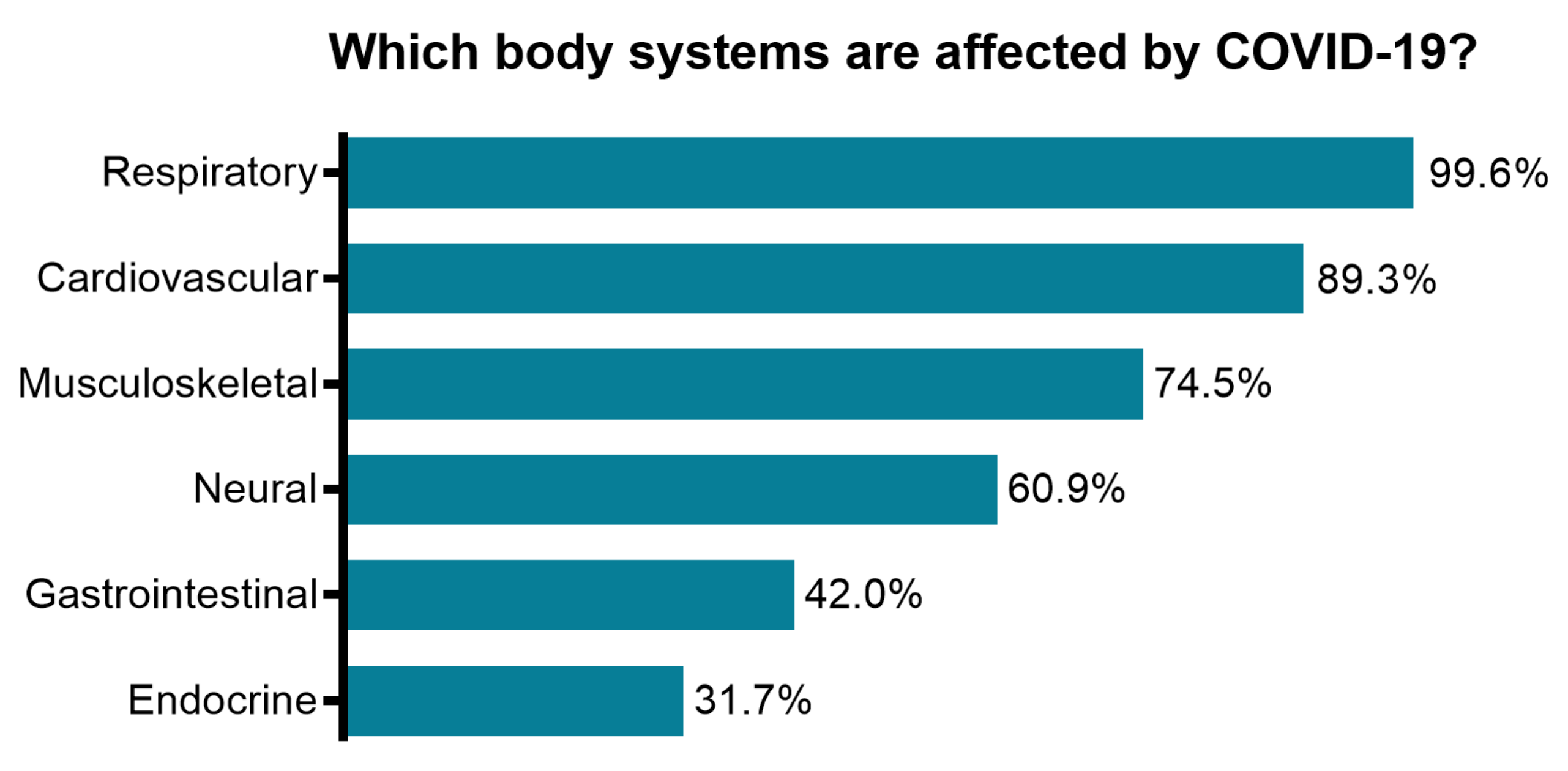
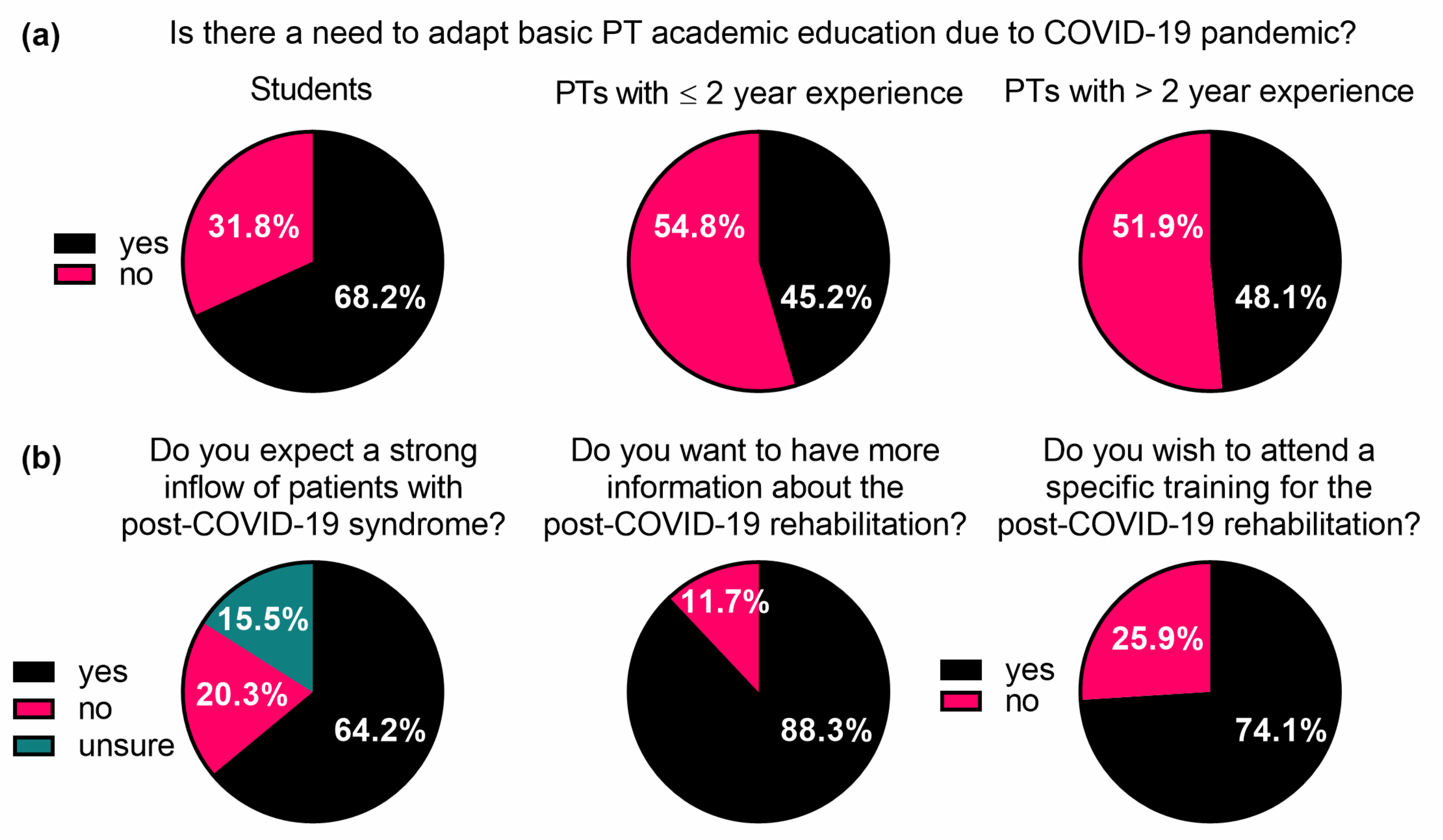
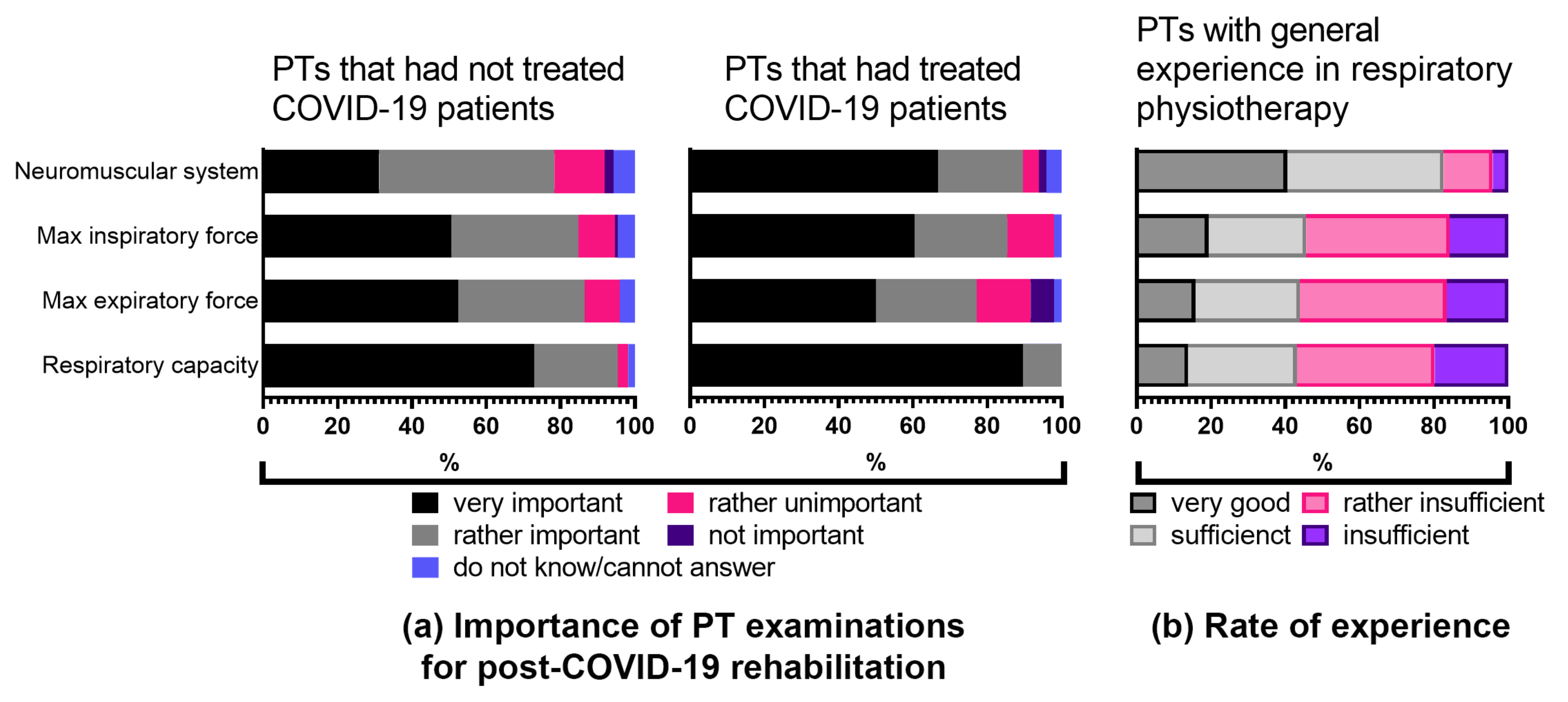
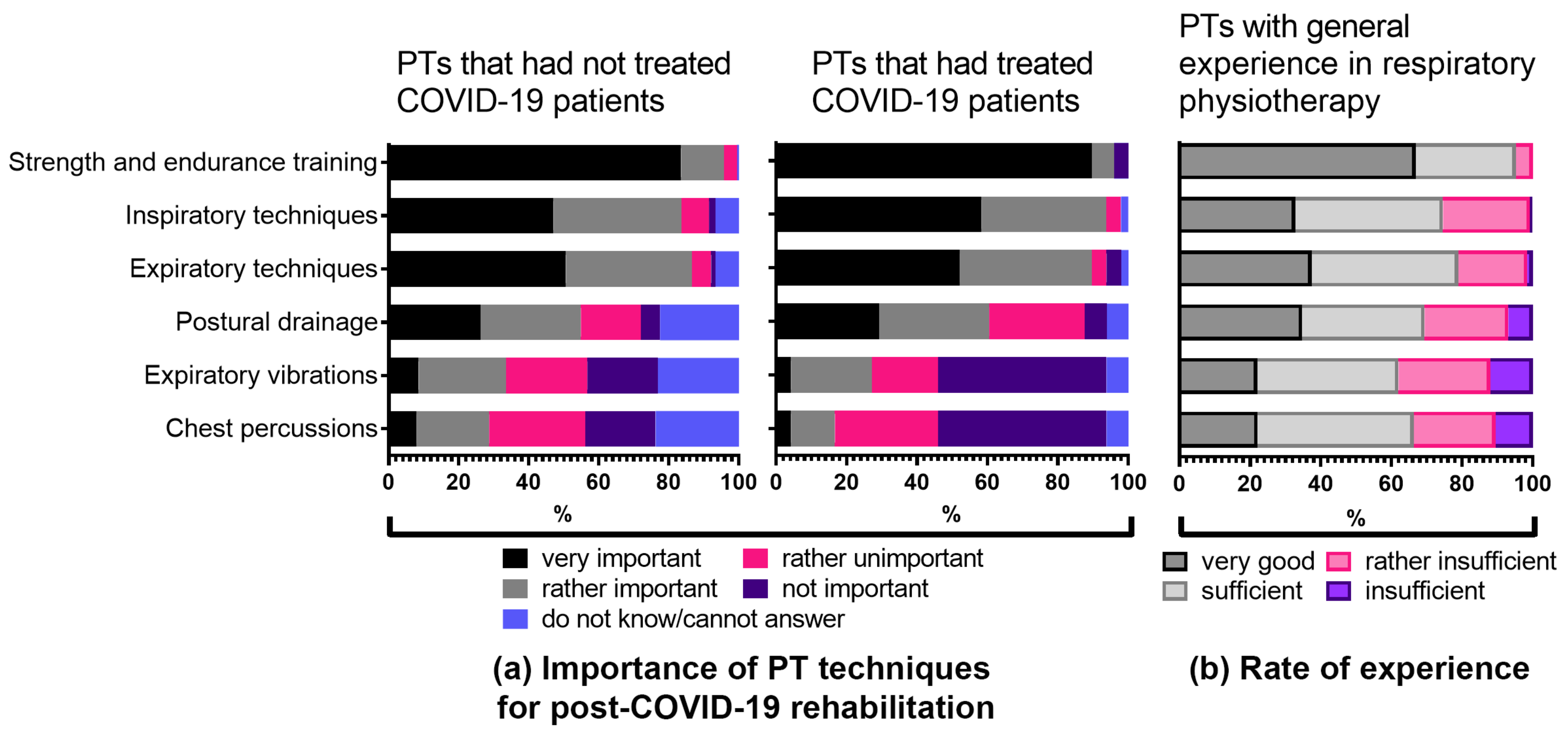
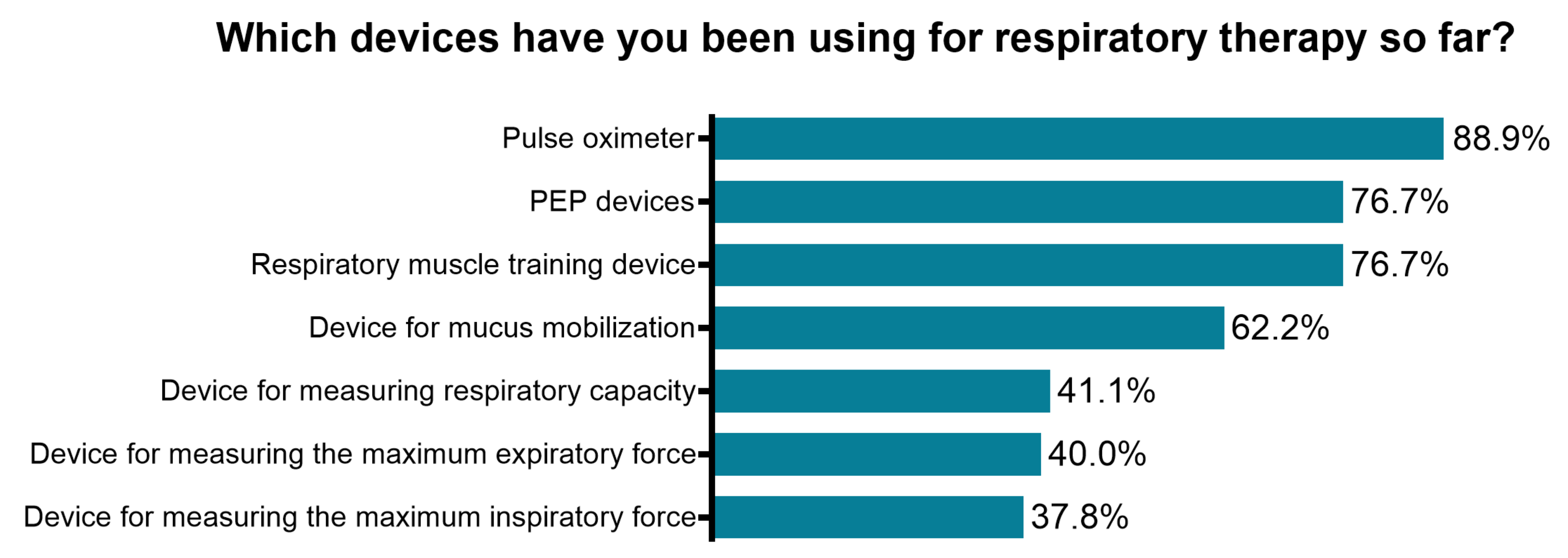
| Respondents | n | % | Mdn | IQR |
|---|---|---|---|---|
| Gender | 255 | |||
| Female | 193 | 75.7 | ||
| Male | 61 | 23.9 | ||
| Not specified | 1 | 0.4 | ||
| Qualification | 255 | |||
| Undergraduate | ||||
| In education | 49 | 19.2 | ||
| Diploma | 71 | 27.8 | ||
| Bachelor | 82 | 32.2 | ||
| Postgraduate | ||||
| Master or equivalent | 50 | 19.6 | ||
| Doctoral degree | 3 | 1.2 | ||
| Work experience b | 203 | 10.0 | 14.0 | |
| ≤2 years | 34 | 16.7 | 1.0 | 2.0 |
| >2 years | 169 | 83.3 | 12.0 | 13.0 |
| Current workplace ab (251 total responses) | 203 | |||
| Independent physiotherapy practice | 139 | 68.7 | ||
| Outpatient rehabilitation | 28 | 13.7 | ||
| Outpatient clinic (public hospital) | 25 | 12.3 | ||
| Outpatient clinic (private hospital) | 12 | 5.9 | ||
| Other | 47 | 23.2 | ||
| Clinical speciality ab (431 total responses) | 203 | |||
| Orthopaedics | 141 | 69.5 | ||
| Traumatology | 101 | 49.8 | ||
| Neurology | 45 | 22.2 | ||
| Internal medicine | 44 | 21.7 | ||
| Geriatrics | 38 | 18.7 | ||
| Paediatrics | 22 | 10.8 | ||
| Gynaecology | 12 | 5.9 | ||
| Other | 28 | 13.8 |
Publisher’s Note: MDPI stays neutral with regard to jurisdictional claims in published maps and institutional affiliations. |
© 2021 by the authors. Licensee MDPI, Basel, Switzerland. This article is an open access article distributed under the terms and conditions of the Creative Commons Attribution (CC BY) license (https://creativecommons.org/licenses/by/4.0/).
Share and Cite
Scheiber, B.; Spiegl, C.; Wiederin, C.; Schifferegger, E.; Schiefermeier-Mach, N. Post-COVID-19 Rehabilitation: Perception and Experience of Austrian Physiotherapists and Physiotherapy Students. Int. J. Environ. Res. Public Health 2021, 18, 8730. https://doi.org/10.3390/ijerph18168730
Scheiber B, Spiegl C, Wiederin C, Schifferegger E, Schiefermeier-Mach N. Post-COVID-19 Rehabilitation: Perception and Experience of Austrian Physiotherapists and Physiotherapy Students. International Journal of Environmental Research and Public Health. 2021; 18(16):8730. https://doi.org/10.3390/ijerph18168730
Chicago/Turabian StyleScheiber, Barbara, Claudia Spiegl, Claudia Wiederin, Erika Schifferegger, and Natalia Schiefermeier-Mach. 2021. "Post-COVID-19 Rehabilitation: Perception and Experience of Austrian Physiotherapists and Physiotherapy Students" International Journal of Environmental Research and Public Health 18, no. 16: 8730. https://doi.org/10.3390/ijerph18168730
APA StyleScheiber, B., Spiegl, C., Wiederin, C., Schifferegger, E., & Schiefermeier-Mach, N. (2021). Post-COVID-19 Rehabilitation: Perception and Experience of Austrian Physiotherapists and Physiotherapy Students. International Journal of Environmental Research and Public Health, 18(16), 8730. https://doi.org/10.3390/ijerph18168730







